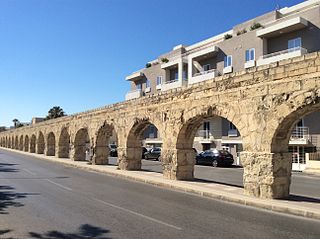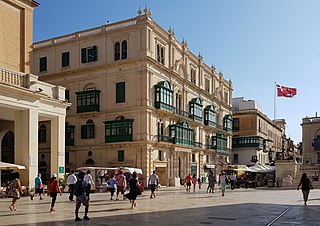
Valletta is the capital city of Malta and one of its 68 council areas. Located between the Grand Harbour to the east and Marsamxett Harbour to the west, its population as of 2021 was 5,157. As Malta’s capital city, it is a commercial centre for shopping, bars, dining, and café life. It is also the southernmost capital of Europe, and at just 0.61 square kilometres (0.24 sq mi), it is the European Union's smallest capital city.

Casa Rocca Piccola is a 16th-century palace in Malta, and home of the noble Maltese family de Piro. It is situated in Valletta, the capital city of Malta. There are daily tours from 10am till 5pm. The palace includes a BnB with 5 rooms and a restaurant called La Giara Restaurant.

City Gate is a gate located at the entrance of Valletta, Malta. The present gate, which is the fifth one to have stood on the site, was built between 2011 and 2014 to designs of the Italian architect Renzo Piano.

Fort Saint Elmo is a star fort in Valletta, Malta. It stands on the seaward shore of the Sciberras Peninsula that divides Marsamxett Harbour from Grand Harbour, and commands the entrances to both harbours along with Fort Tigné and Fort Ricasoli. It is best known for its role in the Great Siege of Malta in 1565.

Sette Giugno is a Maltese national holiday celebrated annually on 7 June. It commemorates events which occurred on that day in 1919 when, following a series of riots by the Maltese population, British troops fired into the crowd, killing four people. This led to increased resistance to the colonial government and support for the pro-Italian irredentists that had challenged the British presence on the island.

Saint James Cavalier is a 16th-century cavalier in Valletta, Malta, which was built by the Order of St John. It overlooks St James' Bastion, a large obtuse-angled bastion forming part of the Valletta Land Front. St James was one of nine planned cavaliers in the city, although eventually only two were built, the other one being the identical Saint John's Cavalier. It was designed by the Italian military engineer Francesco Laparelli, while its construction was overseen by his Maltese assistant Girolamo Cassar. St James Cavalier never saw use in any military conflict, but it played a role during the Rising of the Priests in 1775.

The Grandmaster's Palace, officially known as The Palace, is a palace in Valletta, Malta. It was built between the 16th and 18th centuries as the palace of the Grand Master of the Order of St. John, who ruled Malta from 1530 to 1798, and was also known as the Magisterial Palace. When the knights were expelled by Napoleonic France, it became the National Palace. During the period of British rule beginning in 1800, it was the Governor's Palace.
This page list topics related to Malta.

Republic Square is a piazza in Valletta, Malta. The square was originally called Piazza Tesoreria or Piazza dei Cavallieri, since the treasury of the Order of Saint John was located in the square. After a statue of Queen Victoria was installed in the square in the 19th century, it became known as Queen's Square or Piazza Regina. Although its official name is Republic Square, it is still commonly referred to as Piazza Regina.

The Armenians in Malta are a community of the Armenian diaspora living on the islands of Malta. There are thousands Maltese of Armenian descent, but only some 400-500 identify as Armenians. The rest are assimilated with the locals and consider themselves Maltese. The surnames and documents, saved in their family archives, are indicative of their Armenian origin. The interests of the Armenian Diaspora in Malta are represented by the Armenian Community of Malta.

The Wignacourt Aqueduct is a 17th-century aqueduct in Malta, which was built by the Order of Saint John to carry water from springs in Dingli and Rabat to the newly built capital city Valletta. The aqueduct carried water through underground pipes and over arched viaducts across depressions in the ground.

Saint John's Cavalier is a 16th-century cavalier in Valletta, Malta, which was built by the Order of St. John. It overlooks St. John's Bastion, a large obtuse-angled bastion forming part of the Valletta Land Front. St. John was one of nine planned cavaliers in the city, although eventually only two were built, the other one being the identical Saint James Cavalier. It was designed by the Italian military engineer Francesco Laparelli, while its construction was overseen by his Maltese assistant Girolamo Cassar.

The fortifications of Valletta are a series of defensive walls and other fortifications which surround Valletta, the capital city of Malta. The first fortification to be built was Fort Saint Elmo in 1552, but the fortifications of the city proper began to be built in 1566 when it was founded by Grand Master Jean de Valette. Modifications were made throughout the following centuries, with the last major addition being Fort Lascaris which was completed in 1856. Most of the fortifications remain largely intact today.

The Manderaggio is a neighbourhood in Valletta, Malta. It is located behind the Manderaggio Curtain of the fortifications of Valletta, on the side of Marsamxett Harbour.

Palazzo Ferreria, officially Palazzo Buttiġieġ-Francia, is a palace found near the entrance of Valletta, the capital city of Malta. It was built in the late 19th century. Designed by architect Giuseppe Bonavia, it makes use of an interesting concept of adding local timber balconies to a design inspired from that of buildings in Italy. It is protected as a Grade 2 national monument.

Ponsonby's Column, also known as Ponsonby's Cenotaph, was a monumental column in Valletta, Malta. It was built in 1838 as a memorial to Major-General Sir Frederick Cavendish Ponsonby, a former Governor of Malta, but it was destroyed by lightning in 1864. Its plinth survived, and is now located near Hastings Gardens.

Ġnien is-Sultan, also known as the Giardino della Marina, the Grand Master's Garden or Lascaris Garden, was a garden in Valletta, Malta. It was established in the 17th century by Giovanni Paolo Lascaris, and included a summer residence for the Grand Master. The garden included several Baroque elements designed by Francesco Buonamici.

The statue of António Manoel de Vilhena is a life-sized Baroque bronze statue of António Manoel de Vilhena, a Portuguese Grand Master of the Order of St John. Commissioned in 1734 by the knight Felician de Savasse, it was sculpted by Pietro Paolo Troisi and cast by Aloisio Bouchut. In 1736 it was installed at Fort Manoel in Malta, and it was subsequently relocated a number of times. It was moved to Piazza Tesoreria in Valletta in 1858, to the entrance of The Mall gardens in Floriana in 1891, and to its present location at Pope John XXIII Square in Floriana in 1989.

Close to the Valletta Grand Harbour, St. Barbara Bastion is a flat-faced bastion with a low parapet overlooking the Grand Harbour Area, Valletta, Malta.

Saint George's Square is the principal urban square of Valletta, Malta, located in the centre of the city. It is also commonly known as Palace Square as it faces the Grandmaster's Palace.




















